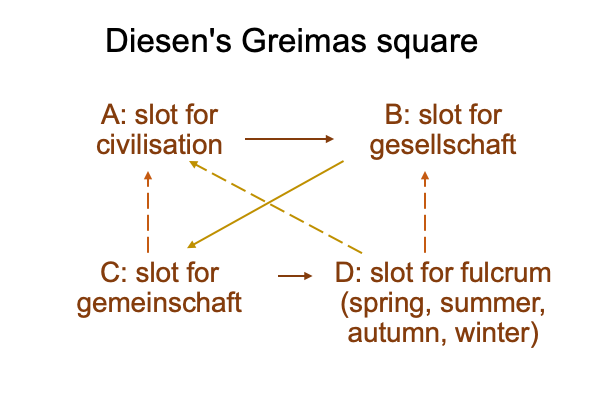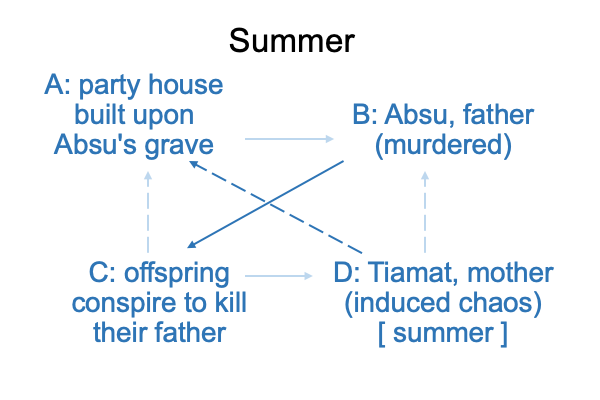0040 In chapter two, Diesen offers several applications.
One paragraph catches my eye.
This paragraph demonstrates that Diesen’s Greimas square has relevance to our current Lebenswelt, all the way back to the first singularity.
How so?
The paragraph recounts one of the written origin stories of the ancient Near East. Since Marduk is the primary actor, I associate this story to the Babylonians, who flourish thousands of years after the start of civilization in Mesopotamia.
Here is Diesen’s Greimas square, once again.

Allow me to recapitulate Diesen’s telling, adding a postmodern flavor.
0041 In the spring, Absu the father (representing order) and Tiamat the mother (representing chaos) comingle. Any adult knows what that means. Children may inquire and get the general impression that the two somehow get mixed up and offspring arise from the confusion.

0042 In the summer, the offspring conjure their own self-anointed revolution and murder the primal order, Absu, who is also their father. They build a house upon his grave. But, since it is summer, this is not any old house. This construction is a party palace. Without the old order to inhibit the offspring, the party house has many chambers. Tiamat, absent Absu, changes from the chaos typical of nature to an induced chaos. Soon, she wearies of all the racket.

0043 In the autumn, the house is assaulted. I presume from within as well as without. Who will impose order over Absu’s dead body? An answer comes from within every chamber. Every party room offers a replacement for Absu’s primal offspring-spawning order.
While everyone is busy naming their substitutes for Absu, a monster, Kino, arises from the tradition that… um… conspired to murder in the first place. This monster (C) contradicts the naming of the one who will impose order over Absu’s dead body (B), while at the same time complements the fact that every offspring in every chamber in the party house screams their substitute in the echo-chamber of their own room (A).
Tiamat, the offspring’s mother, weighs in on the assault upon (and within) the offspring’s party palace (A). Tiamat becomes Chaos Incarnate (D), which may be a harsh way of describing a total control freak.
Think of the second law of thermodynamics and ask the question, “What do control freaks accomplish?” The answer? They create a bubble of anti-entropic perfection (a complex and apparently crystalline order) at the cost of dramatically increasing entropy outside the system (that is, producing disorder that is greater than the energy required to maintain the intended order).
Each chamber of the party house is ruled by a busy-body control freak…
…who is totally weirded out by Tiamat, the control freak of control freakdom, outraged by the clatter of the little busy-bodies.
Kino’s job is to tell the little control freaks to shut up.

0044 In the winter, a god, Marduk, answers the question of who will restore order.

0045 Marduk fights Kino and wins. Then, Marduk makes humans from the undead blood of the monster.
Marduk restores the temple (the home for the gods) and the palace (ah, is that the architectural structure that goes over Absu’s grave?).
At the end of winter, Tiamat has been transformed into an enclosure of her former self.

0046 What does this imply?
Diesen’s Greimas square offers snapshots of civilisational cycles. Plus, some of the written origin myths of the ancient Near East depict civilizational cycles.
His two keywords, “gesellschaft” (rational analytical order) and “gemeinschaft” (irrational traditional community) command slots B and C, respectively.
The concept of civilizational cycles clarifies A (the manifestation of a civilizational balance) and D (the fulcrum, the balance point that dwells beneath the manifestation).
